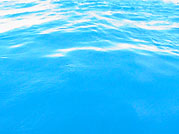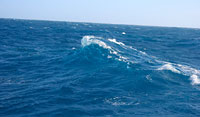

 | |||||||||||||||||||||
|
|
Journals 2008/2009Jeff Lawrence
December 28, 2008 Traveling the ocean during the day is a visual feast of changing colors both in the sky and the ocean itself. One moment the ship can be in very clear water and a few miles later the water can become murky full of biological life within it. It also can show varying colors of blue that are so spectacular a photo can't catch all of the color. The ship also has a sensor on it that determines the amount of carbonate in the water, which is a good sign of coccolithophores. The turquoise color of the ocean is also a good sign. Visible from space this color stands out on satellite photographs, which are sent to the ship daily from NASA. This day was spent in gorgeous turquoise colored water the whole day, indicating a large bloom was in place just to the north of the Falkland Islands. Barney gets excited every time we find water of this color it is quite probable that we are in the midst of a coccolithophore bloom. Sometimes the stations will be plotted according to where a bloom is expected to be, while other times the ships sensor detects carbonate, this will indicate that we are on top of a good spot for coccolithophore. In that case we will stop and complete a CTD cast to gather water samples that are then filtered in the labs aboard the REVELLE.
The ocean waters we are traveling in today were turquoise blue that looked as inviting as a swimming pool on a hot summer day. However these waters are generally quite cold for the middle of summer. We have seen water temperatures vary from 17°C to 7°C so far. Color variations in the water are what these scientists are looking for; the various colors of the water could be a precursor to living organisms in the water. The murky water found in the picture below is due to the runoff from the continent of South America. It was taken as we were leaving port in Montevideo, Uruguay. Rain swollen streams make their way to rivers that empty into the ocean. The sediment is carried away from the interior of a continent and deposited at the mouth of the river, usually into an ocean. Just a few kilometers away from shore and the waters cleared up. Even though we are in the Southern Atlantic Ocean where water temperatures are hovering near 42° and the wind chill makes even seem colder, there are a variety of ocean blue hues to see. We are just south of the Falkland Islands, yet the waters color seems to indicate that we are somewhere in the Caribbean Sea. The Southern Ocean is full of a palette of beautiful colors to gaze upon as we set sail across it. I will miss this daily view when I return to land, for I have seen more shades of blue in the water than I ever dreamed existed.
Questions of the Day:
|
||||||||||||||||||||




